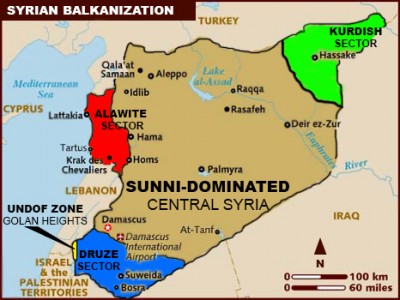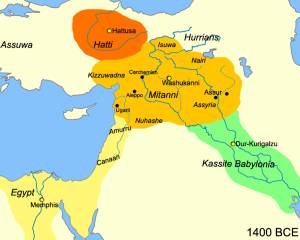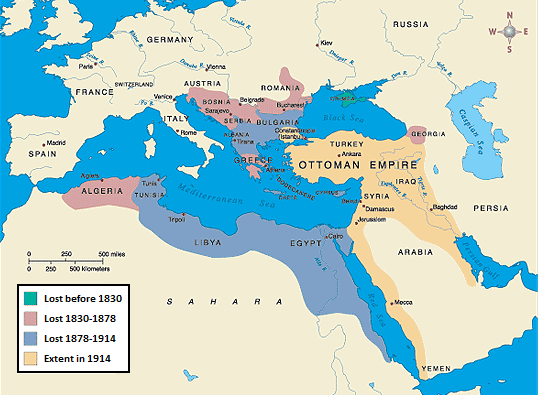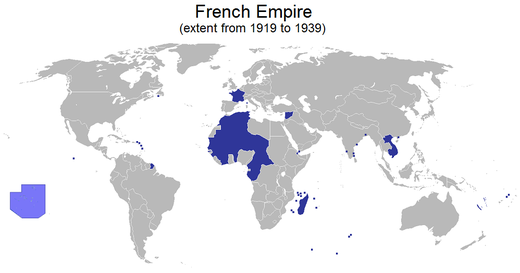Ambrose Bierce is said to be the author of the saying “War is God’s way of teaching Americans geography.” Despite the vigorous national debate about intervening in Syria, there is some reason to think that most Americans could not find it on a map. Here are some key points about Syria that this blog has been trying to underline.
1. Syria is a country in the eastern Mediterranean; northern Syria is due east of Sicily and southeast of Athens. Syria’s population is about 22 million, making it the 54th most populous country in the world, smaller than Ghana, Taiwan and Nepal. The population of a country helps to determine how big its military can be. Syria by this criterion is not very important militarily. Syria does have stockpiles of toxic gas, but these cannot be easily delivered any significant distance and are not effective weapons except against a massed military formation. it is not clear that Syria’s chemical weapons stockpiles are bigger than those of Russia, the US, Israel, and North Korea.
2. Syria is a largely Arabic-speaking country. Arabic is a Semitic language related to Hebrew. But about 10 percent of the population is Kurdish, which speaks an Indo-European language ultimately related to English.
3. Before the revolution that began in 2011, The Syrian economy was diverse. About a quarter of the economy was industry and mining. Retail sales were another quarter. A little over a fifth was agriculture. And tourism accounted for about 12 percent. Syrian industry has been nearly brought to a standstill by the civil war. Millions of Syrians have been displaced from their homes, either fleeing to other cities inside the country or being forced abroad to Turkey, Lebanon and Jordan. Even before the troubles, Syria was a relatively poor country with an annual gross domestic product in nominal terms ($64 bn) that is 65th in the world behind Angola, Cuba and Ecuador.
4. The Syrian revolution and civil war did not begin as primarily sectarian. It is to some extent a class struggle High population growth rates and economic stagnation made the state unable to provide jobs to a burgeoning youth population. Droughts and the bad effects of global warming also created a water crisis that harmed farmers and pushed youth off the farms into city slums where, after the 2008 world crash, there were no jobs. The big protests in 2011 originated in the slums around the cities in the center of the country, where young men who had moved there for work from the countryside found themselves locked into long-term unemployment. The governmental and business elite in Damascus benefits from the regime and has mostly remained loyal or neutral, whether they are Sunnis or Alawites. About half of the large northern city of Aleppo is still with the regime, as well. Because the upper ranks of the ruling Baath Party are disproportionately dominated by the Alawite minority, and because so many discontented youth in the cities of the center are Sunni, the conflict took on a sectarian tinge. But its underpinnings are economic.
5. Some 10 to 14 percent of Syrians are Christians. They speak Arabic and are primarily Eastern Orthodox (like Greece and Russia) or Uniate Catholics, belonging to Eastern churches that at some point recognized the Pope and came into communion with Rome. A few Christian villages still speak Aramaic, the language of Jesus. Syrian Christians tend either to be politically neutral or to tilt toward the ruling regime, being afraid of the more radical Sunni fundamentalists who have come to the fore on the battlefronts of the north, one of which has declared itself an affiliate of al-Qaeda. The clerical hierarchies of the Syrian Christians and their Lebanese coreligionists have strongly come out against a US missile strike on Damascus. Another 10 to 14 percent of Syrians are Alawites, members of a branch of Shiite Islam that is considered unorthodox by other Shiites. They don’t have Friday prayers, and some of their beliefs are New Age-ish. The Alawites predominate in the upper echelons of the ruling Baath Party and the officer corps.
6. If the US were to intervene in Syria, it certainly would not be about oil. Syria was not a significant oil exporter. By 2009 it was producing less than 400,000 barrels a day. The world produces on the order of 90 million barrels of oil a day, and some countries like Russia and Saudi Arabia by themselves produce in the neighborhood of 10 million barrels a day. Nor is Syria necessary to pipelines in the region. Iraq’s northern fields feed into Turkish pipelines, and Turkey is anyway so far much more stable than Syria. Syria’s production has been more than halved by the war, but the loss to the world markets is minor. Libya’s production has fallen by nearly a million barrels a day in the past year because of oil worker strikes and autonomist, Eastern claims on resources, and this shortfall has barely produced any comment in the American press.

7. Some 60% of Syrians are Sunni Arabs, i.e., adherents of the Sunni branch of Islam who speak Arabic as their mother tongue. Sunni Arabs also predominate in Jordan and Egypt. Large numbers of Syrian Sunnis are secularists, either nationalists or leftists, and not very observant. Many Syrian Sunnis still follow the tolerant, mystical Sufi form of Islam. Others have come under Saudi influence and are known as Salafis, but this is just a euphemism for Wahhabis, members of the intolerant and rigid form of Islam practiced in Saudi Arabia. A very small number of Sunnis have affiliated with al-Qaeda, but they have had the important battlefield victories in the north.

8. Contemporary Westerners imagine they are the pinnacle of civilization, but they are newcomers to the phenomenon by Syrian standards. Syria is the site of the ancient civilization of Ebla, between 4,000 and 5,000 years ago. It was later ruled by Assyria, the Pharaohs of Egypt, Babylon, Persia/ Iran, Macedonia, and Rome/ the Byzantines. Along with Palestine, after the death of Jesus around 33 AD/ CE, Syria was a site of the spread of Christianity. St. Paul had his conversion on the road to Damascus, and I was once shown a building he was said to have stayed in in what is now a Christian quarter of the city. Between the time of Jesus and around 600, it gradually became mostly Christian. Beneath Damascus are the catacombs where early Christians hid from persecution. It was conquered by the Arab Muslims in 634-640. Over many centuries thereafter, the people of Syria gradually began speaking Arabic instead of Aramaic, and gradually converted to Islam from Christianity and Judaism. There is no evidence that violent coercion was at the root of this conversion, though there were tax advantages and it was a way to move up socially. Arab Muslim rule of Syria was challenged in the medieval period by the Crusaders and the Mongols, both of which were fought off. Medieval Syria may have been 50% Shiite, but the dynasty founded by Saladin imposed Sunni orthodoxy after he conquered it in 1175-1185.
9. In 1516 Syria fell to the Ottomans based in Istanbul in what is now Turkey, and was ruled by the Sunni Muslim Ottoman empire until World War I. In 1916 Britain and France secretly concluded the Sykes-Picot agreement, which awarded Syria to France if the allies defeated the Ottomans (who sided with the Germans and Austrians in WW I). The British allied with the Arabs of the Hijaz and Jordan to push the Ottomans out of Syria toward the end of the war, a story told in the classic David Lean film, “Lawrence of Arabia” (1963). But the French were outraged that the British had connived to foster an Arab state in Syria in 1918-1920, and in 1920 they invaded and asserted their claim under Sykes-Picot. The some 20 years of French rule in Syria was the worst example of colonial administration in French history, and few French historians have bothered to write about it. In 1944 Syria was recognized by the allies as an independent country (France having been colonized by Germany was in no position to continue to colonize Syria).
10. Independent Syria suffered from a series of military coups. The March, 1949 coup of Husni al-Za`im may have been encouraged behind the scenes by the Truman administration because his predecessor had objected to an oil pipeline that was to go through Syrian territory. In 1958-1961, Syria was joined with Egypt in the United Arab Republic. In 1963 officers of the Arab nationalist Baath (Resurrection) Party, which claimed to be socialist, made a coup. The Baath is still in power in Syria. In 1970 Air Force general Hafez al-Assad, an Alawite, made an internal coup, and in 2000 he was succeeded by his second son Bashar, an opthalmologist trained in England. The Baath is a brutal one-party state characterized by a secret police that intensively spies on the population and punishes dissent with arbitrary arrest and torture. It raised standards of living and brought the country from being overwhelmingly rural farmers to having a slight urban majority.






 © 2025 All Rights Reserved
© 2025 All Rights Reserved